Influencer whitelisting is a marketing strategy that involves partnering with influencers, or individuals with a large following on social media or other platforms, to promote your product or service. By building relationships with influencers and inviting them to join a whitelist, you can leverage their credibility and reach to boost your sales and increase brand awareness.
One of the main benefits of influencer whitelisting is that it allows you to tap into the trusted relationships that influencers have with their followers. Influencers often have a loyal following of individuals who trust their opinions and recommendations, and by partnering with them, you can gain access to this audience and potentially convert them into paying customers.
In addition to increasing your reach, influencer whitelisting can also help to boost your sales by increasing the credibility and perceived value of your product or service. When an influencer endorses your product, it can be perceived as a stamp of approval, which can help to boost consumer confidence and increase the likelihood of a purchase.
To be effective, it is important to carefully select the influencers you work with and ensure that they are a good fit for your brand. Look for influencers who have a genuine interest in your product or service and who are able to authentically promote it to their followers.
Another key to success with influencer whitelisting is to offer incentives to influencers to encourage them to promote your product or service. This could include offering them free products, discounts, or other perks.
In conclusion, influencer whitelisting is an effective marketing strategy that can help boost your sales and increase brand awareness. By partnering with influencers and offering incentives, you can tap into their credibility and reach to drive traffic and conversions.
What is influencer whitelisting?
Influencer whitelisting is a process in which a company or organization creates a list of approved influencers who are allowed to promote their products or services. This list is typically created to ensure that the company’s brand and reputation are protected by only working with influencers who have a positive reputation and align with the company’s values and messaging.
Influencer whitelisting is often used in social media marketing, where companies use influencers with large followings to promote their products or services to a wider audience. By creating a whitelist of approved influencers, companies can ensure that the influencers they work with meet certain criteria and are not likely to damage the company’s reputation through their actions or content.
In order to be whitelisted, influencers typically have to go through a vetting process, which may include providing information about their followers, engagement rates, and content history. Companies may also require influencers to sign a contract or agreement outlining the terms of their partnership and any requirements for content creation or promotion.
Don’t confuse influencer whitelisting with paid partnerships
Influencers typically collaborate with brands through paid partnerships and sponsored posts on their profiles, or by sharing products that have been gifted to them by brands.
It is often required by law for influencers to disclose any paid content by using hashtags such as #sponsored or #gifted or by explicitly stating the partnership at the beginning of the post. You can find more information about branded content policies on Facebook and Instagram.
In most cases, sponsored influencer content will include a declaration of the partnership at the top of the post.
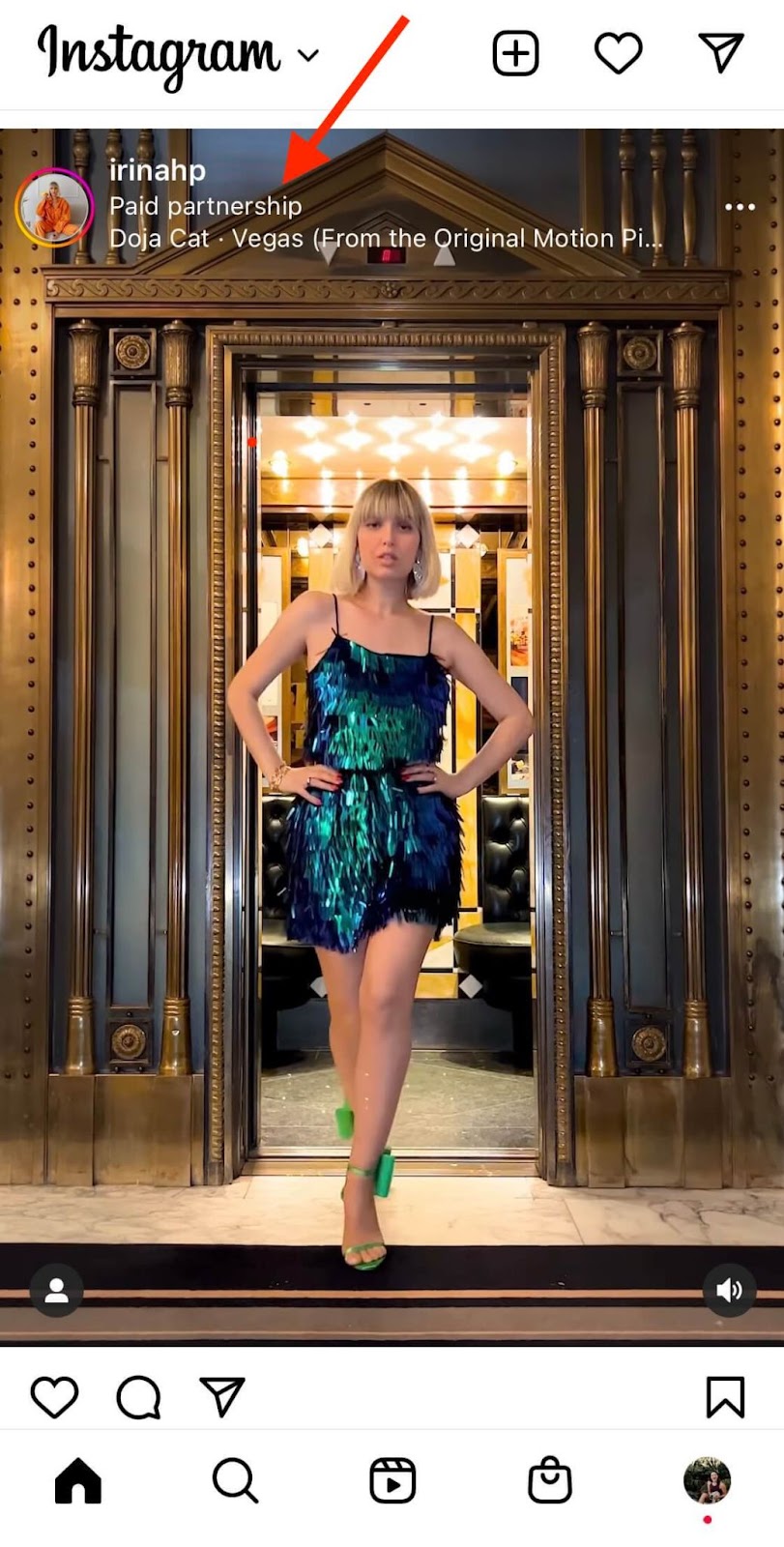 Influencer whitelisting is not the same as running a paid partnership or using influencer-generated content for branded ads.
Here is an example of a brand using an influencer for their sponsored content, which is not whitelisting:
Influencer whitelisting is not the same as running a paid partnership or using influencer-generated content for branded ads.
Here is an example of a brand using an influencer for their sponsored content, which is not whitelisting:
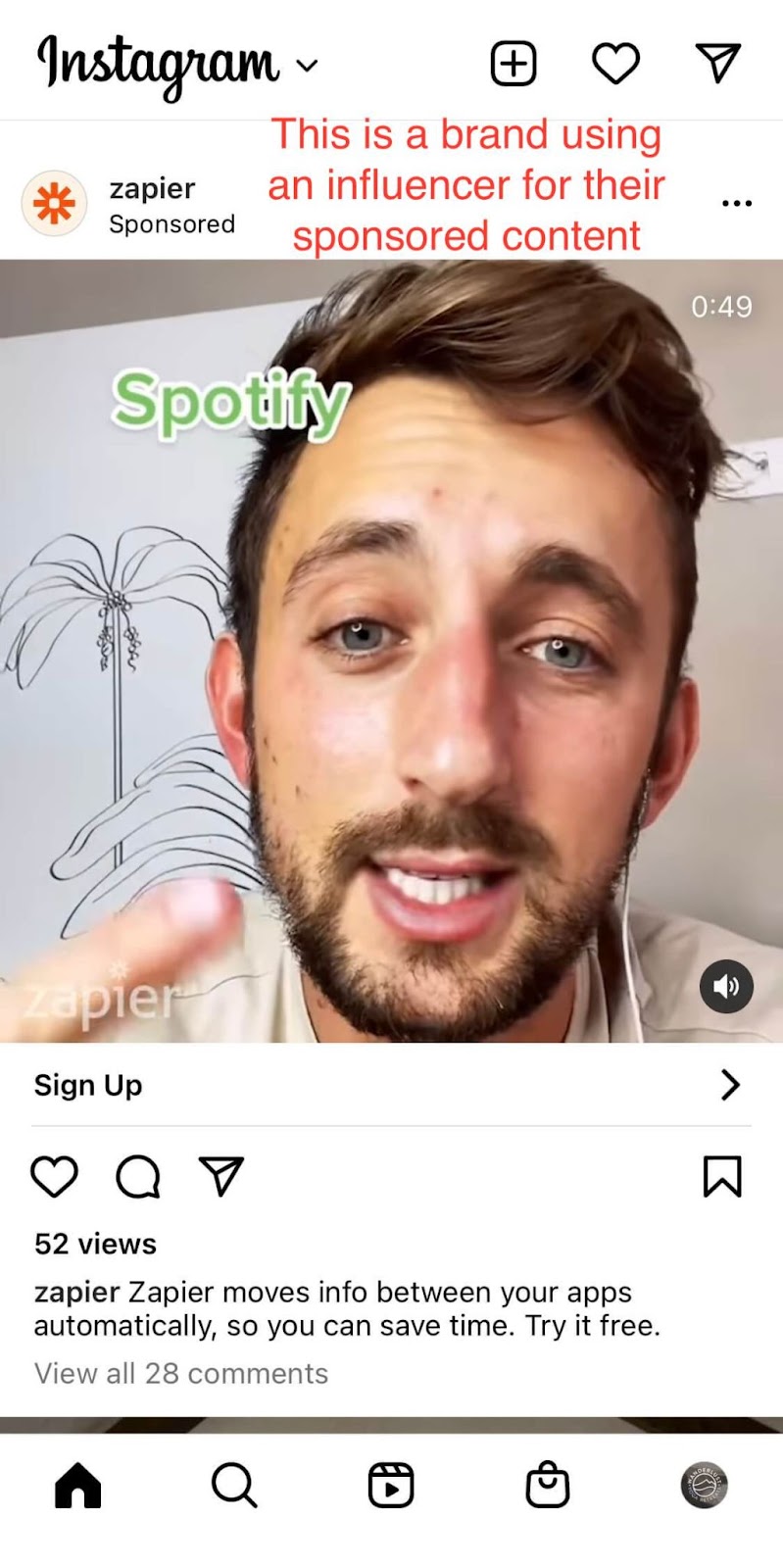 When it comes to whitelisting, the brand posts as the influencer, and the post appears as follows:
When it comes to whitelisting, the brand posts as the influencer, and the post appears as follows:
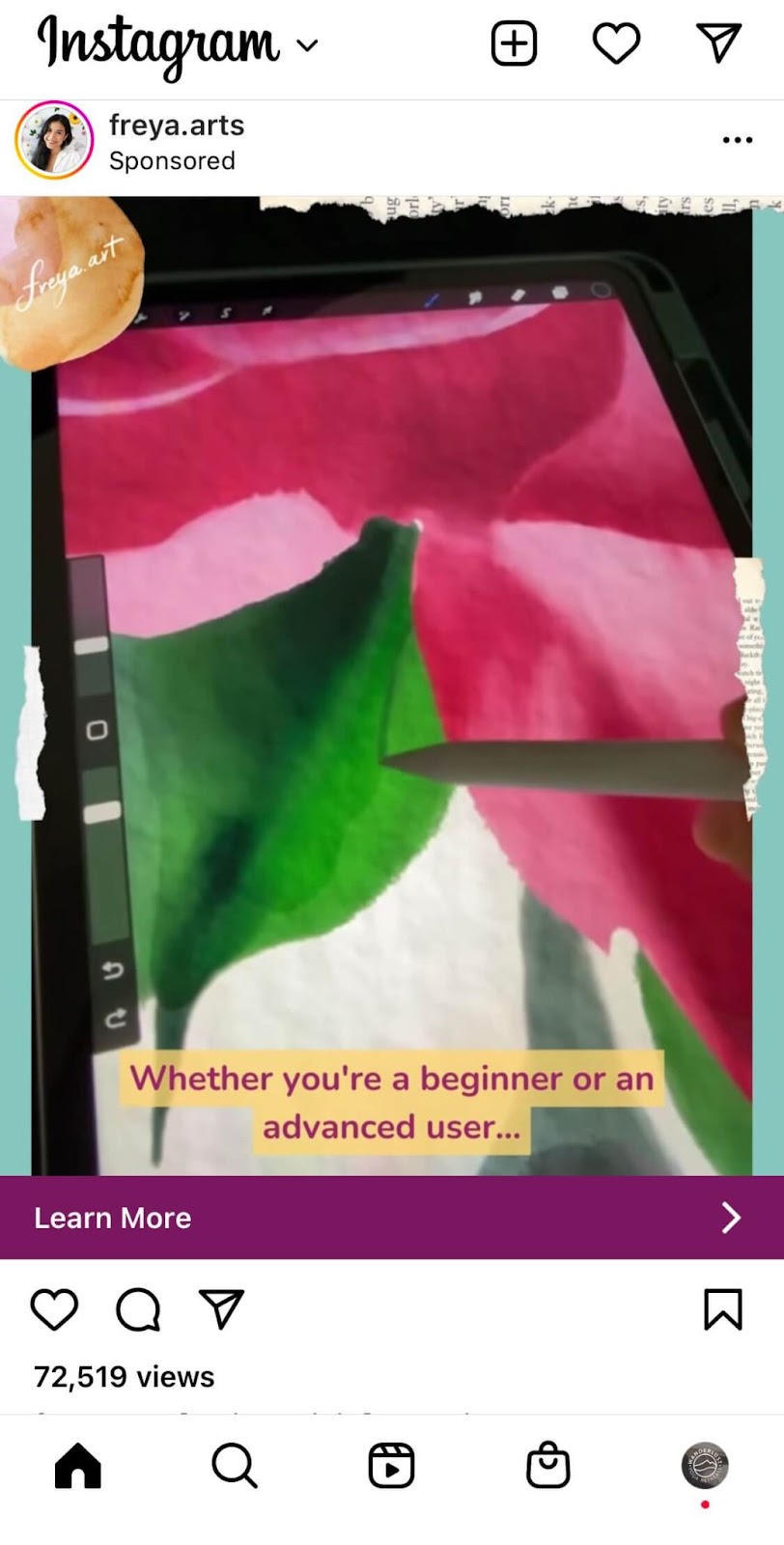 In this scenario, the brand is sponsoring a post about a tablet on the influencer’s Instagram account, but it only appears on the user’s timeline and not on the influencer’s profile. This is an example of whitelisting.
In this scenario, the brand is sponsoring a post about a tablet on the influencer’s Instagram account, but it only appears on the user’s timeline and not on the influencer’s profile. This is an example of whitelisting.
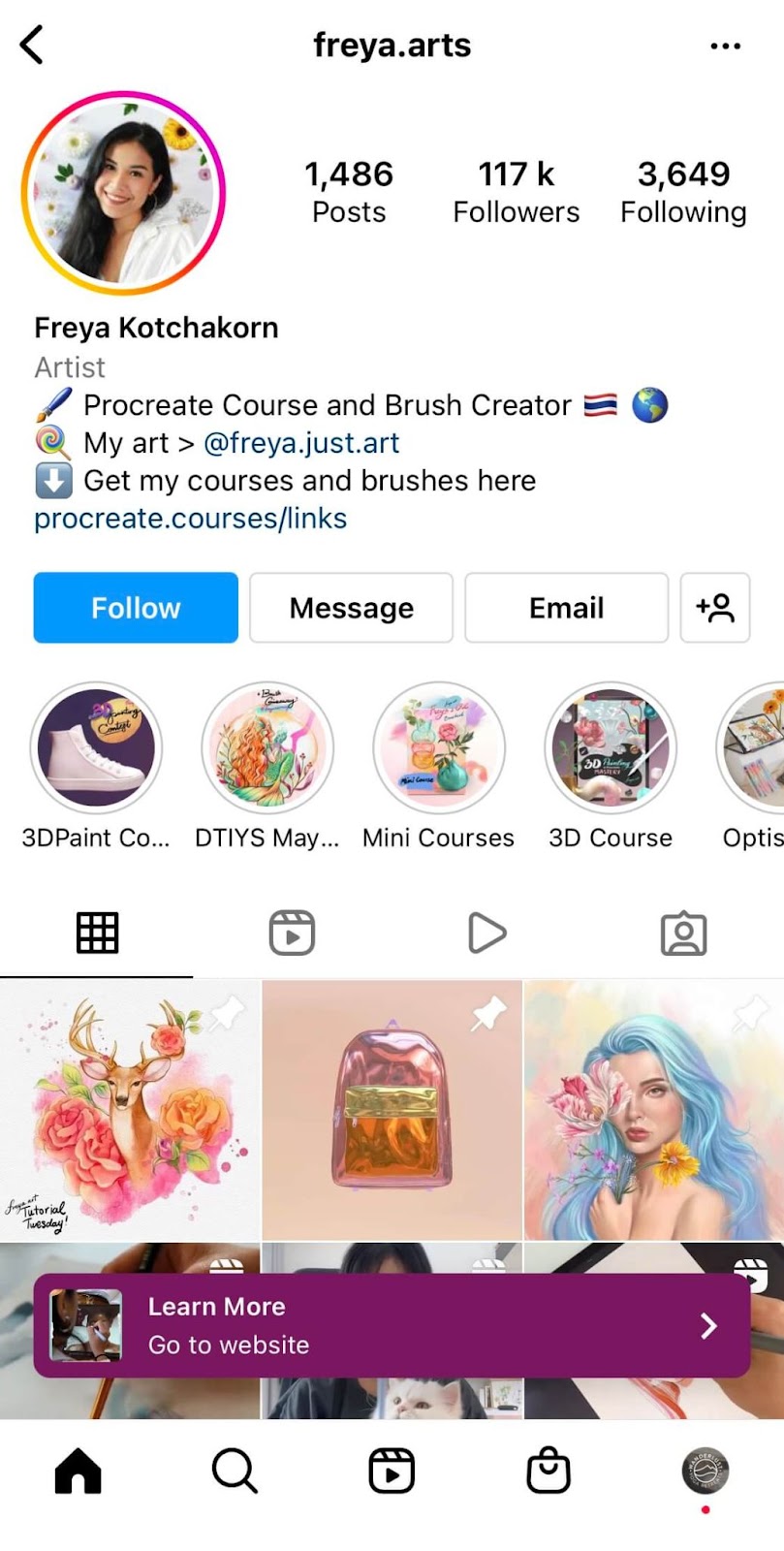 Which brings us to our next question…
Which brings us to our next question…
What is dark posting?
Dark posting involves a brand running ads using an influencer’s handle, but these posts do not appear on the influencer’s feed. Instead, they are only visible to a specific target audience. This means that not all of the influencer’s followers will see a dark post, only those who are part of the targeted group.
One advantage of dark posting is that it allows a brand to test different versions of a post and target them to different audiences without cluttering the influencer’s feed.
It is also a way for brands to leverage an influencer’s credibility without using organic posts with sponsored hashtags, as organic content typically only reaches about 5.5% of someone’s followers. By putting money behind dark posts, a brand can ensure that more people will see them.
What are the pros and cons of whitelisting for a brand?
One of the most effective ways for companies to increase their return on investment in advertising and expand their influencer marketing efforts is through influencer whitelisting.
By partnering with the right influencers, businesses can effectively amplify their brand messaging and generate significantly more engagement and conversions than they would with a sponsored brand post.
Here are a few reasons why influencer whitelisting is worth considering:
Pros of influencer whitelisting for a brand
- Influencer whitelisting allows you to advertise directly to an influencer’s audience
- Consumers tend to trust posts made by influencers more than those made by brands
- It is easier to track and calculate return on investment using tools such as Facebook Business Manager or Meta Business Suite than it is to do so with paid partnerships or sponsored posts
- You can gain full visibility of the customer journey
- You can use data from an influencer’s audience to create new advertising audiences
- Whitelisted content has a longer lifespan than sponsored content in an influencer’s organic feed
- You can continually test and optimize whitelisted content, such as changing calls to action, copy, images, or targeting a different audience
- You can increase engagement on sponsored content and improve the return on investment for your ad spend
Cons of influencer whitelisting for a brand
- Collaborating with influencers can be unpredictable, as they may cancel or halt your ads at any time
- Negotiating and agreeing on content to post can be time-consuming
- The approval process and access requirements involved in influencer whitelisting may be more complex than running sponsored ads from your own brand account
- Influencers may charge higher fees for whitelisted content compared to generic sponsored posts.
What are the pros and cons of whitelisting for an influencer?
As an influencer, there are several benefits to allowing a brand to whitelist your profile, as well as some potential drawbacks:
Pros of whitelisting for an influencer
- Allowing a brand to whitelist your profile allows you to take advantage of their advertising budget and reach a larger audience
- The brand’s advertisements will be shown to both your audience and their own, which means your profile will be exposed to more people
- You may see an increase in followers and likes on your page or profile
- It is an additional source of income for you, as you can charge a flat fee or a percentage per post
- You only need to create the content, as the brand handles everything else, including creating, running, and optimizing the ads.
Cons of whitelisting for an influencer
- If you allow a brand to control your advertising, you may lose some control over the content shared under your handle
- By allowing a brand to whitelist your profile, you are sharing your audience, which you may have spent a long time building and earning trust from, with the brand.
Why create an influencer whitelisting strategy?
According to research, almost half of consumers view influencer recommendations as more trustworthy than branded content and consider them to be influential in their purchasing decisions. Influencer whitelisting ads can amplify this potential and help brands achieve significant results on a larger scale. Other key advantages include:
Amplified reach through advertising
Influencer marketing can go beyond just reaching the organic network of an influencer.
Retail brands have the opportunity to use the influencer’s account to access first-party data and target specific audiences that may be interested in their products.
By doing so, they can increase the chances of getting more users to watch their ads, engage with them, and ultimately make a purchase.
This approach can be especially effective in reaching potential buyers who are not already following the influencer.
Optimized content through A/B testing
Whitelisting allows for greater flexibility in optimizing influencer content for better performance.
Brands have the option to test multiple versions of the same ad and use the data from their performance to fine-tune the content and maximize Return on Ad Spend (RoAS).
This allows for more informed decision-making and a higher chance of achieving desired results.
Performance data insights
Influencer whitelisting enables brands to closely track the performance of their ads with each influencer.
Rather than relying on the influencer for analytics every time they work together, brands can collect this data directly and use it to optimize their strategies and achieve better results.
Key metrics like impressions, engagement, click-through rate, and conversions are important for evaluating ad spend and refining the strategy.
With whitelisting, brands have the ability to gather detailed data directly from the source, without the need for a middleman.
This can help them make more informed decisions and achieve their desired outcomes.
Improved targeting
Influencer whitelisting can potentially provide a higher return on investment because it allows brands to more effectively advertise their products and ensure that the ad and brand messaging are effective in generating results.
Collaborating with influencers who have similar target demographics can increase the chances of reaching the right audience and generating conversions.
Additionally, access to audience and content metrics allows brands to create lookalike audiences that are likely to have a strong affinity for their products, further enhancing their targeting strategy.
Overall, whitelisting can help brands effectively reach and engage their desired audience, leading to better outcomes.
Best practices around influencer whitelisting
Influencer whitelisting allows retail brands to take their paid advertising to the next level by giving them direct access to an influencer’s account, insights, and controls for creating more on-brand content.
However, without a carefully planned strategy, whitelisting campaigns may not be successful. Here are five best practices to consider when developing an influencer whitelisting strategy:
Choose niche influencers—both micro and macro
The effectiveness of your influencer whitelisting strategy is closely linked to the type of influencers you work with. Instead of just focusing on metrics like number of followers, it is important to choose creators who are aligned with your brand values and personality to ensure consistency in messaging and maximize return on ad spend. It can be helpful to consider influencers with different numbers of followers to understand engagement levels and invest more budget in those that produce the best results. In fact, micro-influencers (influencers with a following of 1,000 to 10,000) often have a higher engagement rate (3.86%) than mega-influencers (influencers with a following of over 100,000) (1.21%).
When selecting influencer partners for whitelisted campaigns, it can be helpful to consider the following criteria:
- Audience: the demographics they cater to and their relevance to your brand
- Authenticity: the type of content they produce for their personal and sponsored posts
- Quality: the creative appeal of the content they post to attract your target audience
- Reliability: their communication style, turnaround times, etc.
For example, cosmetics brand Jones Road Beauty collaborated with micro-influencer Carolyn Gray, whose content includes honest reviews of cosmetics and beauty products. This partnership was a good fit for Jones Road because it aligned with their values and helped them reach their target audience.
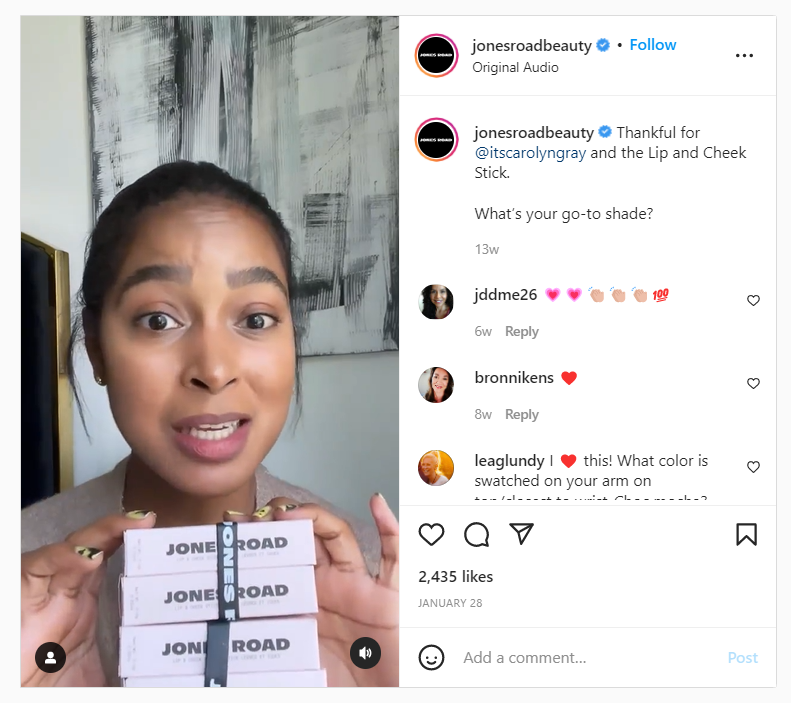
Once you have a shortlist of potential partners, it is important to brief them about whitelisting and how it will benefit them. Be sure they understand what the relationship will look like and what both parties will gain from it. Essentially, whitelisting can help both parties get more visibility for their content, resulting in increased sales for the brand and more followers/engagement for the influencer.
“Remember that not all influencers are familiar with the concept of whitelisting, so it’s vital to share all the information and benefits of whitelisting when creating a relationship with them,” advises Savannah Sanchez, founder of The Social Savannah.
Create a targeted content strategy
Having a well-defined content strategy will be an important foundation for your whitelisting ad campaigns. By providing clear guidance on your brand messaging, preferred content formats, campaign goals, and key performance indicators (KPIs), you can give influencers the information they need to create content that resonates with your target audience.
Here are some tips to help you create an impactful whitelisting content strategy:
- Define your messaging before deciding on the type of ad, platform, and format to use.
- Evaluate your content performance to see what your audience likes. For example, compare the engagement rate of your Instagram stories and carousels to determine the best format to use.
- Focus on creating short-form videos, as video ads tend to perform well on social media channels.
- Experiment with different ways of collaborating with the influencer to find the best arrangement that benefits both parties.
“Once you find someone who genuinely loves your products and creates good content, you can start talking about paying for content. You can either use existing content or pay them to produce new content that you can run through their handle,” says Cody Plofker, Director CMO at Jones Road Beauty.
According to a survey, 38% of shoppers base their buying decisions on influencer reviews, so whether you’re paying for new content or repurposing old material, whitelisting can unlock significant sales potential. It provides better targeting through custom and lookalike audiences, access to first-party data for optimizing ads, and consistent messaging across your marketing channels.
Define custom and lookalike audience sets
Whitelisting influencers can provide a new way to reach new audiences. You can create custom audiences by combining followers from your top-performing creators with your primary target audience.
This allows you to reach users who fit into your target demographic but may not have been aware of your brand.
Creating lookalike audiences based on the network of your influencers is another effective way to increase the visibility of your ads.
Through whitelisting, you have direct access to the influencer’s account, which allows you to analyze which users have engaged with the influencer’s content or visited their profile, enabling you to create a more specific and accurate lookalike audience.
Your ads can also reach a larger audience of interested prospects beyond those you were initially targeting, potentially resulting in more conversions and bringing new opportunities with a new audience to your attention.
Prepare a plan and test often
One of the main advantages of influencer whitelisting over traditional marketing is the ability to edit a post and test the impact of your ads through A/B testing.
This allows you to make data-informed decisions and achieve better targeting, leading to increased revenue.
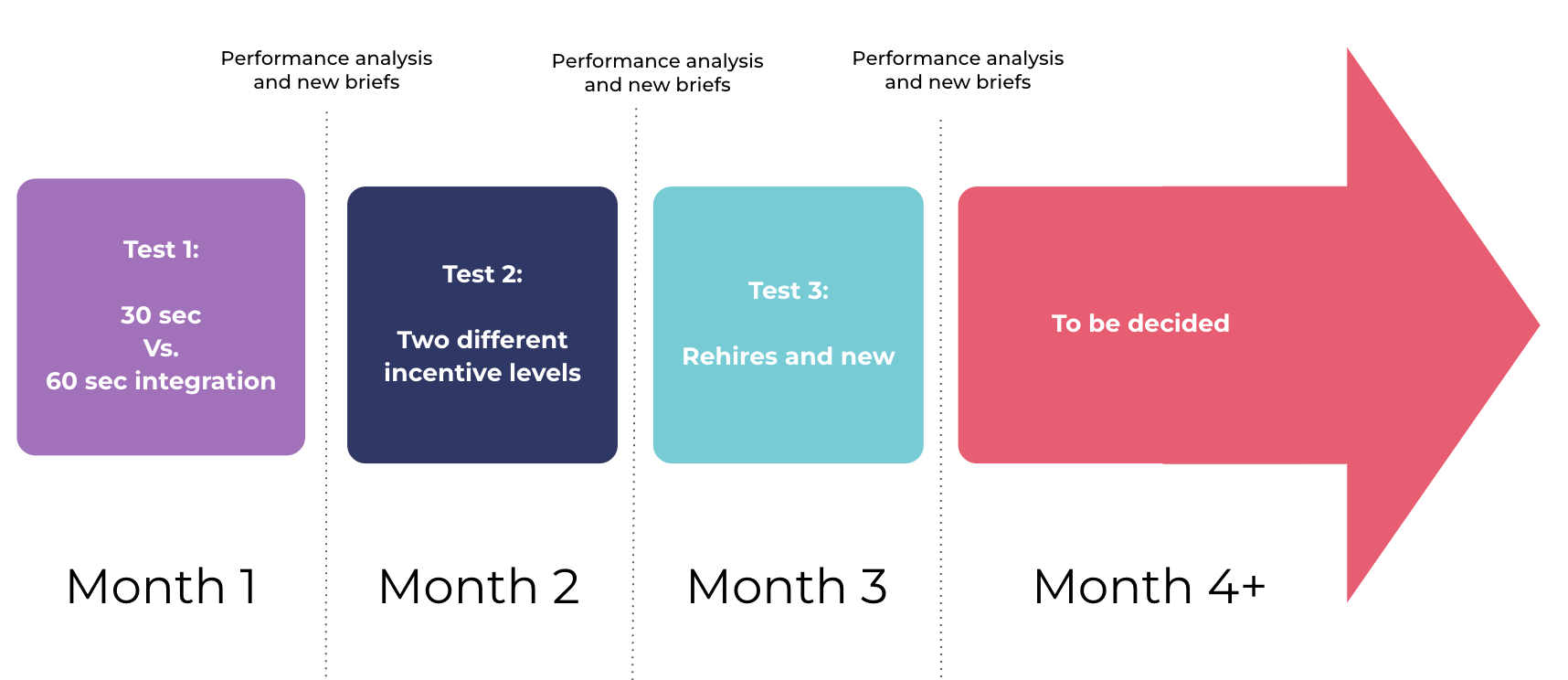
To optimize the content of your creator ads, it is important to have a solid testing strategy in place. A three-month framework for testing whitelisted ads, optimized for one parameter per month, might include the following:
- Ad format: Identify the content format that produces the maximum brand lift.
- Creative design: Review and improve the overall appeal of the ad’s design to deliver the best viewer experience.
- Call to action: Determine which CTA copy works best and the ideal placement for your CTAs.
- Video subtitles: Add subtitles as needed and decide on the style of subtitles that aligns with your brand’s colors and font to build recall value and further advance brand awareness.
A/B testing provides a mathematical analysis of how your creative assets will perform and offers actionable suggestions for improvements. This can result in more reliable results and a higher conversion rate.
Pick your metrics to assess progress
Approximately 15% of brands spend more than half of their marketing budgets on building creator partnerships, so it is crucial to accurately calculate the return on investment (ROI) of your whitelisting campaigns and optimize your strategy to get the most value for your money.
While there is no one-size-fits-all approach to evaluating your progress, you can define relevant key performance indicators (KPIs) that align with your campaign goals.
One advantage of whitelisting is that you can use the influencer’s in-app insights to assess metrics like impressions, engagement, and clicks. You can also use tools like Google Analytics to cross-reference and gain access to deeper insights such as conversions, traffic, and traffic-to-conversion ratio.
Here is a list of metrics for your whitelisted ads that can be mapped to popular goals:
- Building awareness: Evaluate metrics like impressions, search volume and mentions for your brand, and website traffic.
- Boosting engagement: Review the number of likes/comments/shares, number of new followers, number of post saves, and profile visits.
- Increasing sales: Calculate the number of conversions through attributable link tracking for each ad and sales through personalized promo codes.
Tracking your ad performance and regularly reviewing your whitelisting strategy is an effective way to improve the results of your ad campaigns. By combining quantitative and qualitative metrics, you can understand the true value of your influencer ads and adjust your strategy to create more targeted content with influential creators at a cost that provides a good ROI.
How to set up influencer whitelisting on Instagram (and Facebook)
For brands and influencers: Setting up Facebook Business Manager
To run ads on Facebook or Instagram, both the brand and the influencer will need to have a Facebook page and a Facebook Business Manager account. Even if you typically run influencer campaigns on TikTok or YouTube, your influencers will still need to set up a Facebook account if they don’t already have one. It is a quick process that can be done by following these simple steps.
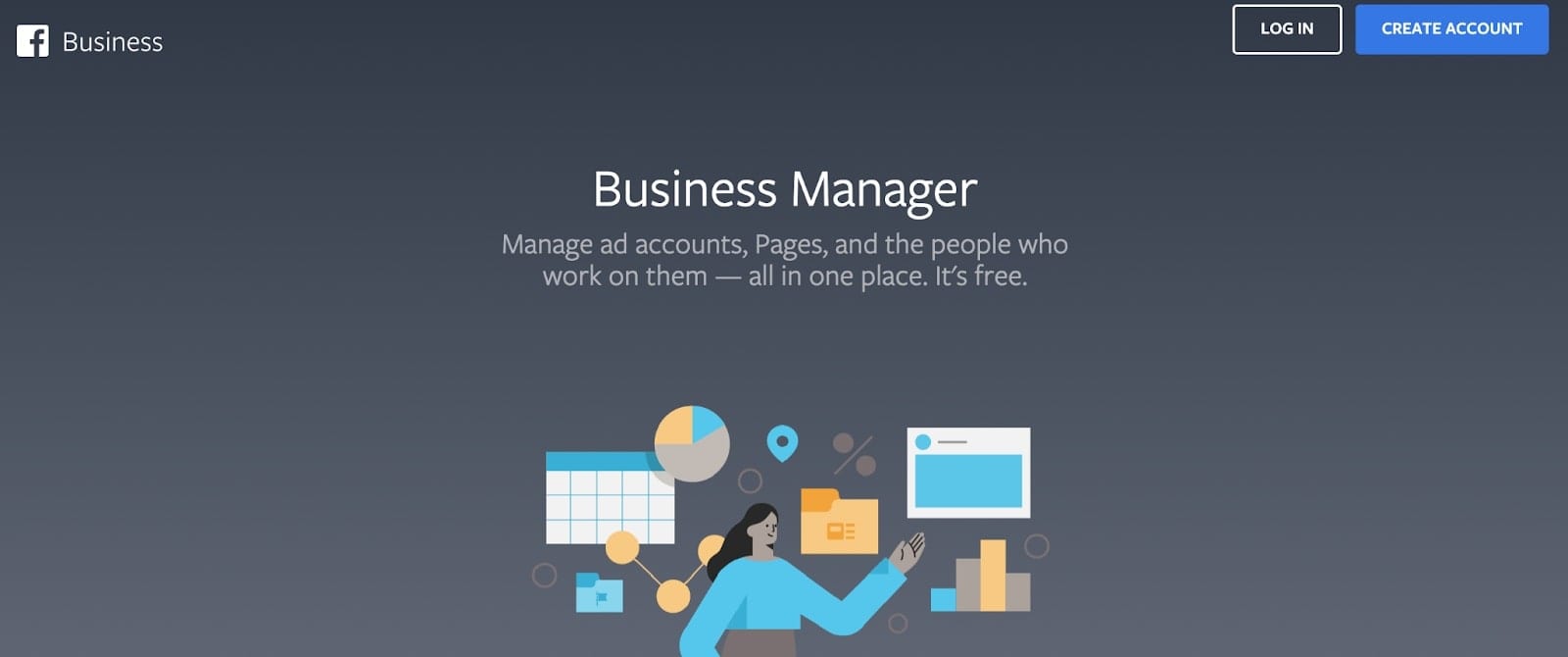
For influencers: Sharing assets with your brand partner
To give brands access to content within Facebook Business Manager, influencers can follow these steps:
- Open Facebook Business Manager > Business Settings > Users > tap Partners.
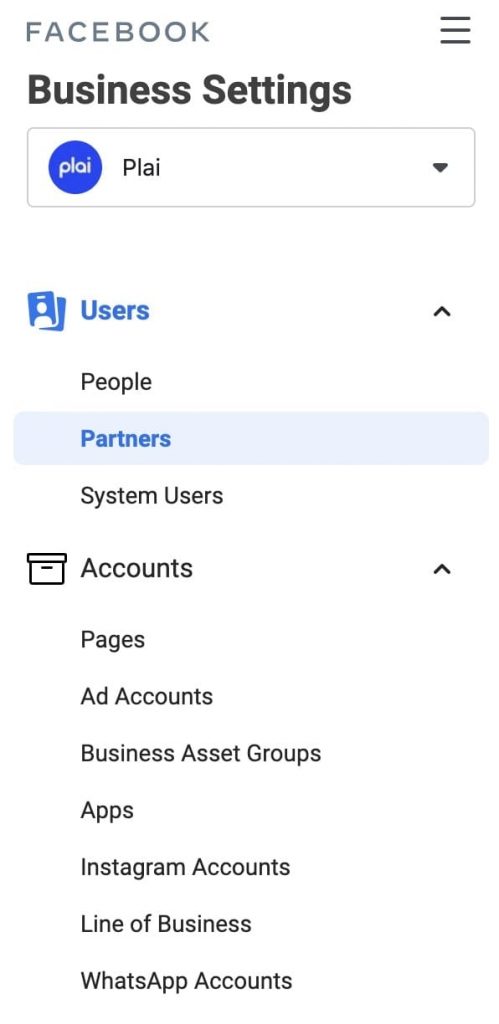
- Tap the Add dropdown > select Give a partner access to your assets.

- Enter the brand’s Facebook Business Manager ID > tap Next.
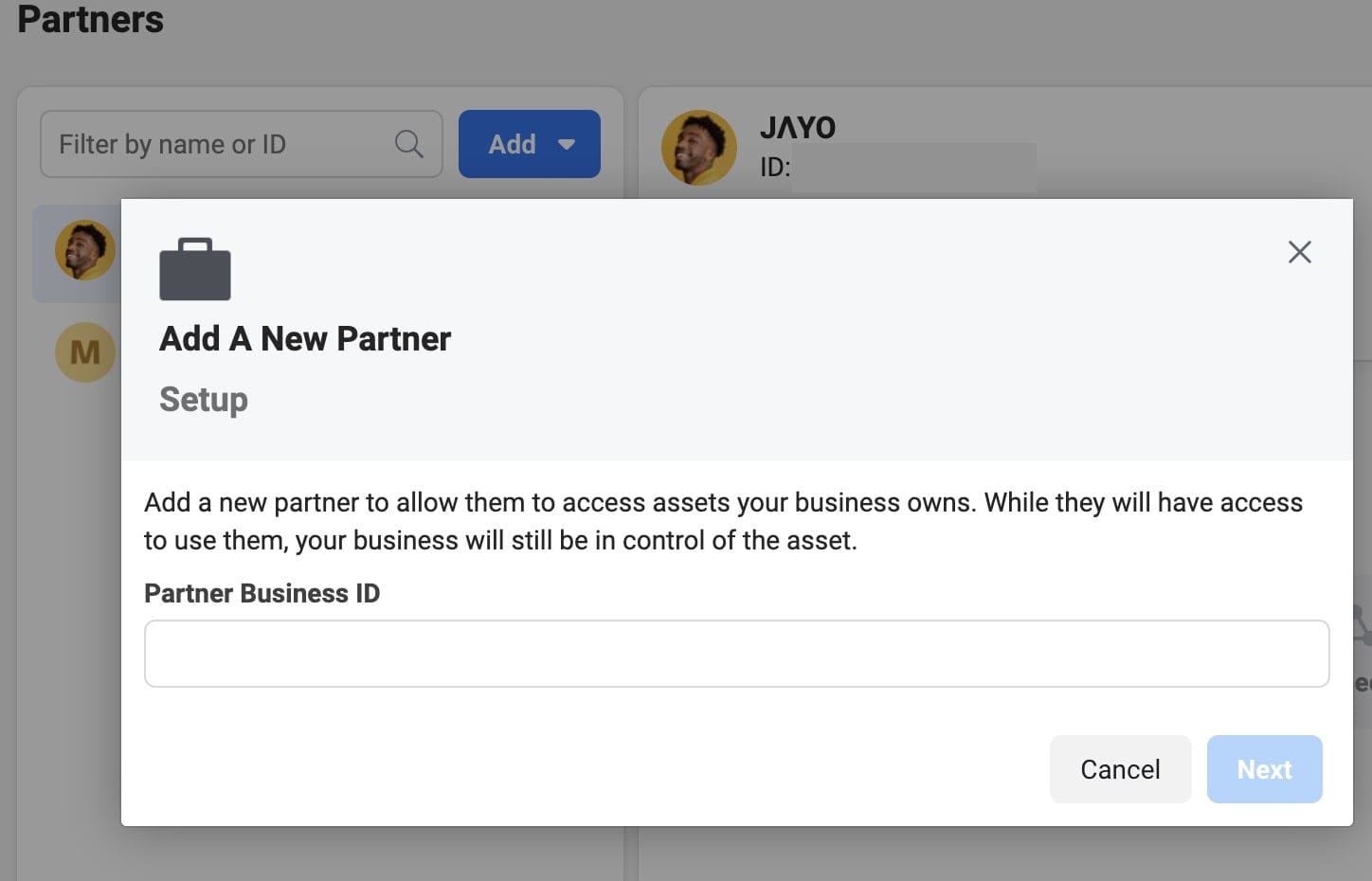
- Select the assets and permissions that the brand partner should have access to.
- Choose the Facebook Page and Instagram Account assets that the brand will use for whitelisting.
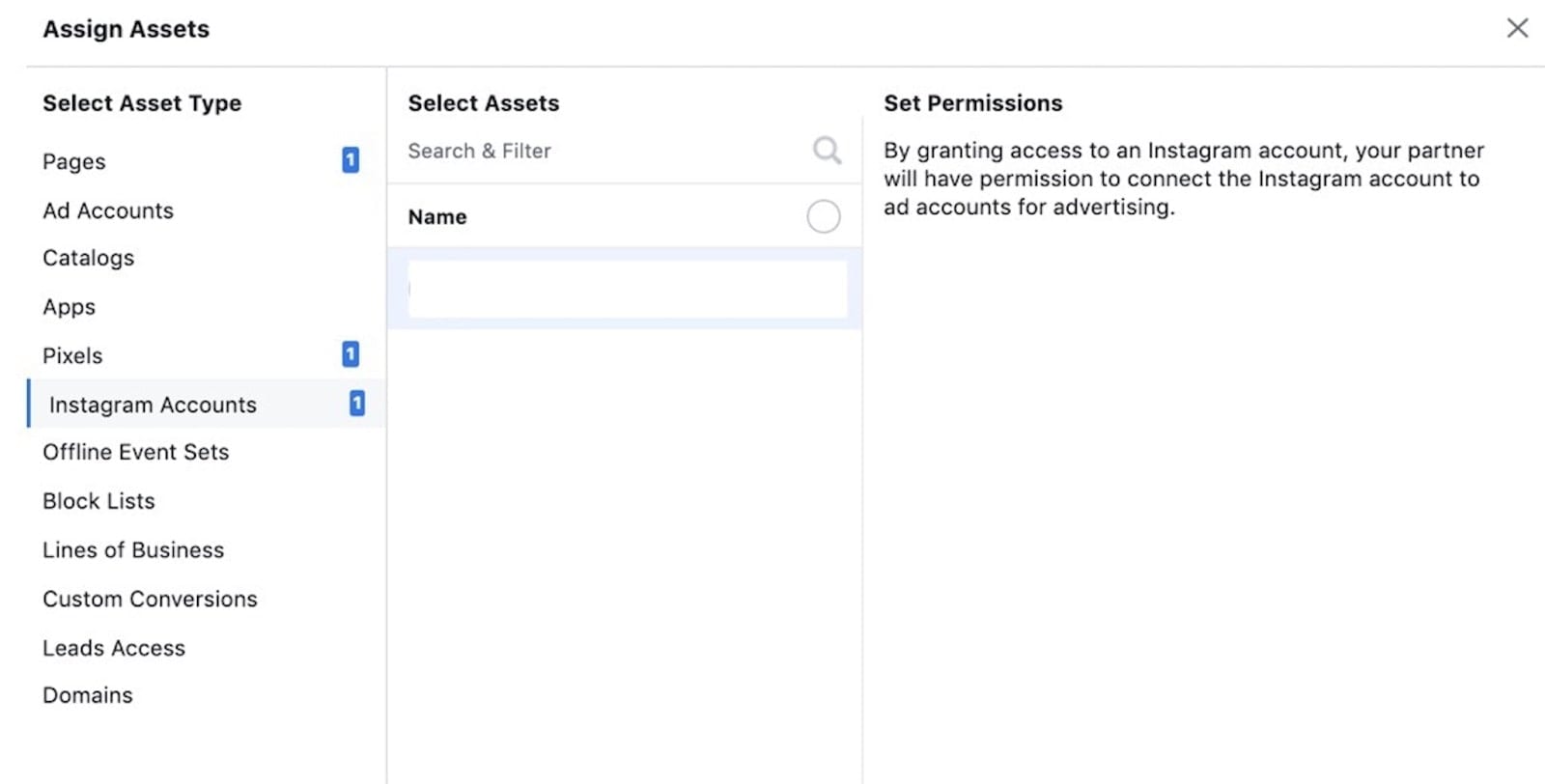
- Set the permissions level to Create Ads.
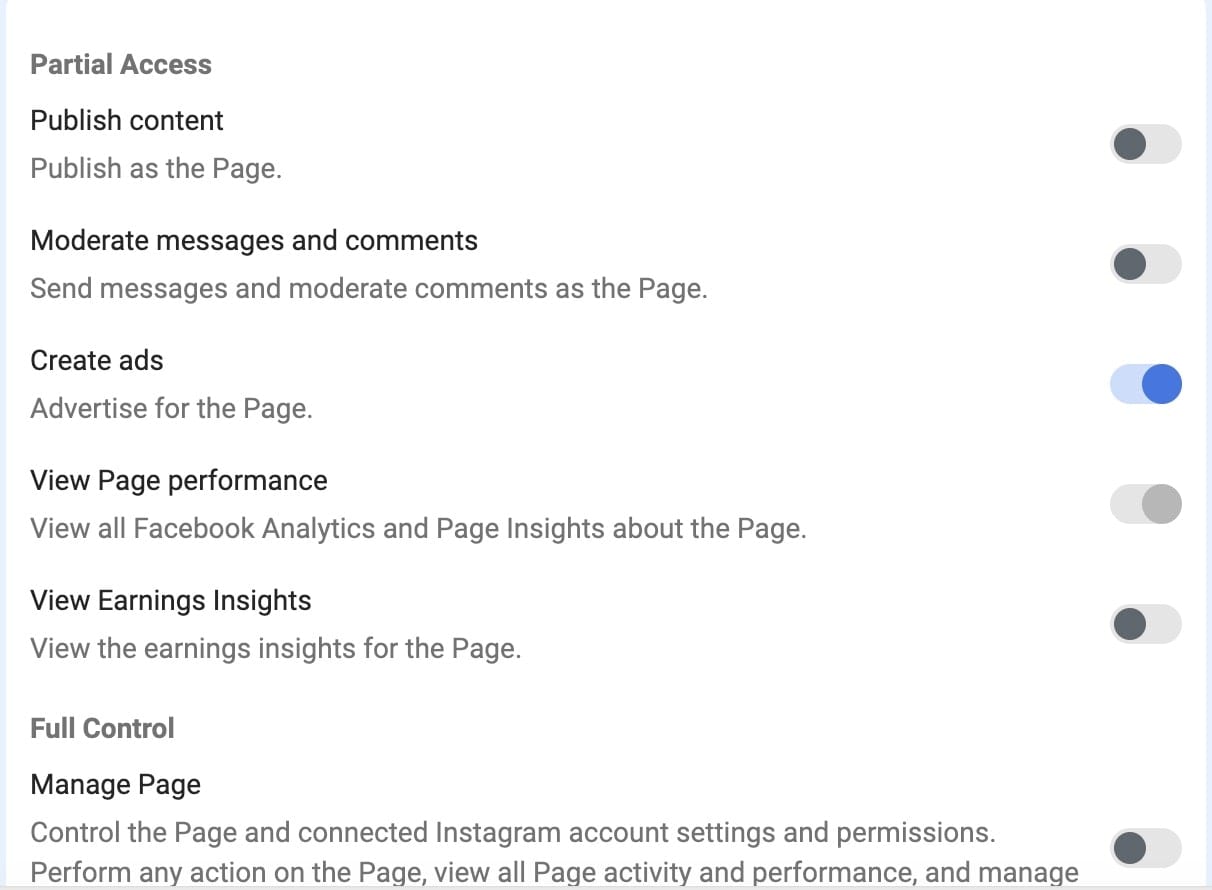
- Save changes.
You can share the step be step setup guide for influencers: Influencer Marketing-Step by step setup guide for influencer
Once these steps are completed, the influencer’s Instagram account and Facebook page will be ready for whitelisting. As a top tip, brands can request access to pixels to help build custom audiences that match their target customer demographics for even better targeting.
What is TikTok Whitelisting?
TikTok whitelisting, also known as Spark Ads, is a process where creators or influencers allow brands to use their content and run ads from their accounts.
This means that brands can promote their products or services using authentic, organic content from the creator or influencer.
When you publish these creator licensed ads or Spark Ads, users can interact with the content by commenting, sharing, and liking, which can increase the reach of the brand.
An example of a brand using Spark Ads might look like a post from a creator or influencer promoting a product or service, with a disclaimer indicating that it is a sponsored ad.
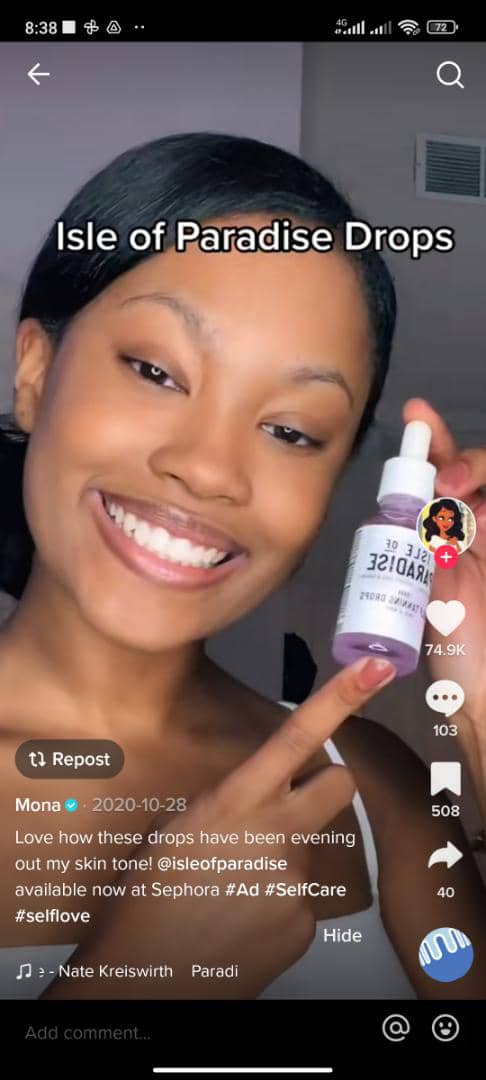 Isle of Paradise, a company looking to boost product sales, partnered with creators to create organic content.
Isle of Paradise, a company looking to boost product sales, partnered with creators to create organic content.
They then launched a Spark Ads campaign using this content and saw impressive results, including a 500% return on investment (ROI), a 68% increase in weekly revenue, and 48 million video views.
This demonstrates the potential success that can come from using TikTok whitelisting or Spark Ads as a marketing strategy.
Influencer Whitelisting on TikTok Case Study
Creator campaigns are a popular form of TikTok advertising because they offer a level of authenticity.
You may have come across several Spark Ads while using the app.
As an example, BlendJet, a portable blender company, ran a Spark Ad campaign in 2021 featuring lifestyle influencers, foodies, and fitness creators using the product in a variety of how-to videos and mixing hacks.
These types of ads can be effective in showcasing the capabilities and uses of a product to a TikTok audience.
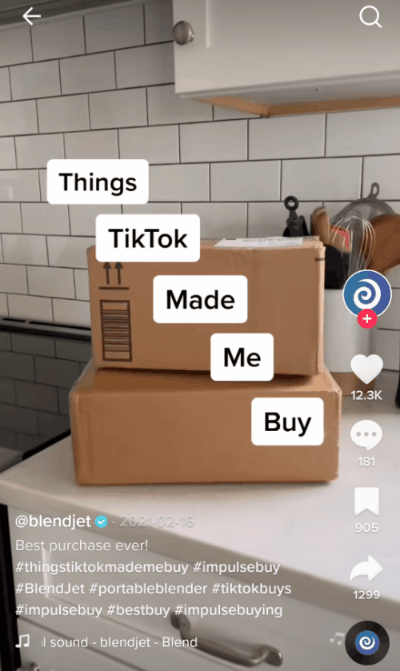 The authentic, hashtag-driven content of BlendJet’s Spark Ad campaign was very successful, resulting in 28 million impressions, 407,000 clicks, and 12,000 conversions.
The authentic, hashtag-driven content of BlendJet’s Spark Ad campaign was very successful, resulting in 28 million impressions, 407,000 clicks, and 12,000 conversions.
Another example of a successful creator ad campaign is Little Moons’ promotion of their mochi desserts on TikTok.
When demand for the product was high and they were difficult to find in stores, Little Moons ran a Spark Ad campaign announcing that the desserts would be available at UK’s Tesco chain for one day only.
This approach capitalized on the buzz surrounding the product and was likely effective in driving sales.
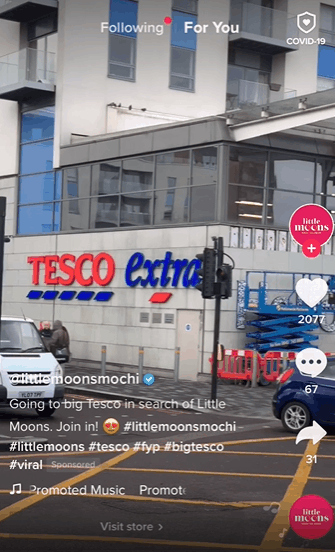 Little Moons’ creator campaign was highly successful, resulting in a 1,300% increase in in-store sales, 6.7 million campaign impressions, and a 4.54% engagement rate.
Little Moons’ creator campaign was highly successful, resulting in a 1,300% increase in in-store sales, 6.7 million campaign impressions, and a 4.54% engagement rate.
These examples demonstrate the effectiveness of using creators as the focus of advertising campaigns on TikTok.
The process of building such campaigns using the whitelisting feature is streamlined and efficient.
What Are the Requirements for Whitelisting on TikTok?
To use TikTok’s Spark Ads feature and run creator campaigns, there are a few requirements that both brands and creators need to fulfill.
TikTok Whitelisting Requirements for Brands
- Brands need to have access to the TikTok Ads Manager and have the ability to run ads on the platform.
- It is helpful if the brand has already established relationships with the creators they wish to whitelist, and they should be prepared to coordinate with the creators to decide on the details of the campaign, such as which video to promote and the duration of the campaign.
- Creators should also be prepared to work with the brand to determine these details and ensure that the campaign runs smoothly.
It is possible to find influencers through the TikTok Creator Marketplace, but this post focuses on whitelisting creators that a brand already has established relationships with.
TikTok Whitelisting Requirements for Creators
- To participate in TikTok’s Spark Ads feature as a creator, you will need to enable your account to share videos with brands. This can be done through a few quick changes in your TikTok settings.
- You will also need to be prepared to share the code for the video you wish to whitelist and to follow up with the brand about the performance and interactions of the whitelisted video.
- It is important for creators to be proactive and open to communication with the brand to ensure a successful campaign.
How to do Influencer Whitelisting on TikTok
If you have a good working relationship with a creator and want to start a campaign using TikTok’s Spark Ads feature, here is a summary of the steps involved:
Step 1. Choose the video they want to promote
To get started with a creator campaign on TikTok using the Spark Ads feature, the first step for the brand is to choose the video they want to promote.
This can be done by reviewing the creator’s content and selecting a video that will work well as an ad.
Some factors to consider when making this decision include
- Recent organic content that has received strong engagement, videos that have gone viral, and videos that showcase the brand’s latest products or promotions.
- The number of views a video has received as an indicator of its potential strength as an ad.
- Reach out to the creator to ask which of their branded posts have performed well in the past.
It is important to note that, unlike on Instagram, TikTok’s whitelisting feature does not grant access to all of a creator’s account assets. Instead, the brand must specify a specific video to promote before proceeding.
Step 2 (Creator): Authorize Advertisements and Share the Video’s Post Code
This is the only step in the process of getting approved to advertise on TikTok that requires the creator’s participation.
The creator will need to allow the brand to use their content and provide the unique code for the video that the brand wants to promote.
If the creator has worked with brands before, they will likely know what to do. If not, don’t worry! The creator just needs to go to their TikTok account settings and follow these steps:
- Select “Creator tools” and turn on “Ad Settings”.
- Enable “Ad authorization” (this will prompt the creator to authorize their content for promotion).
- After choosing a time frame, tap “Authorize”.
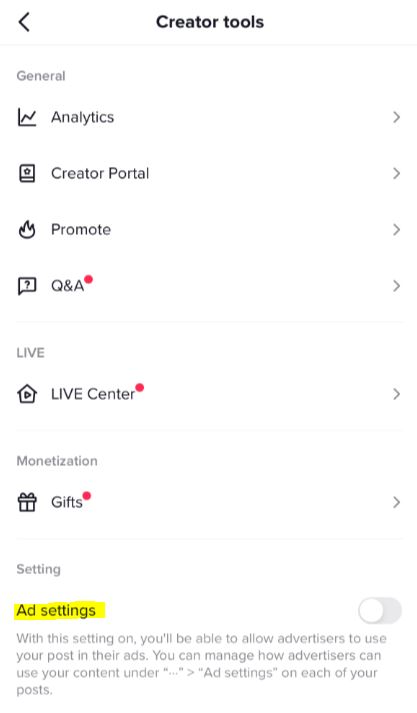
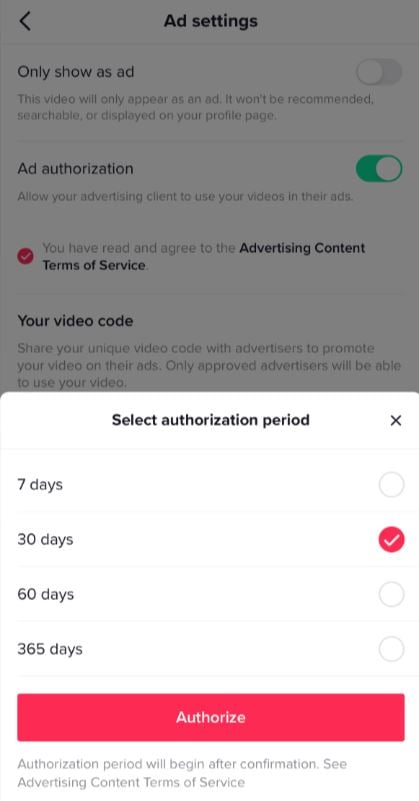 On this screen, creators will also be given a video code that they need to share with the brand. The brand will need to coordinate with the creator to get this code, which can be done through a direct message or email.
On this screen, creators will also be given a video code that they need to share with the brand. The brand will need to coordinate with the creator to get this code, which can be done through a direct message or email.
The video code should appear as a random combination of numbers, letters, and special characters.
Once the brand has access to the video code, the creator’s role in the approval process is complete for the time being.
Step 3 (Brand): Approve the Video to Run as an Ad (Enter the Post Code)
At this point, the brand takes over the process. Here’s what needs to be done now that you have the video code:
- Log in to the TikTok Ads Manager.
- Click on “Assets” at the top of the page and then select “Spark Ad posts” on the left side.
- Click the “Apply for Authorization” button in the center of the screen.
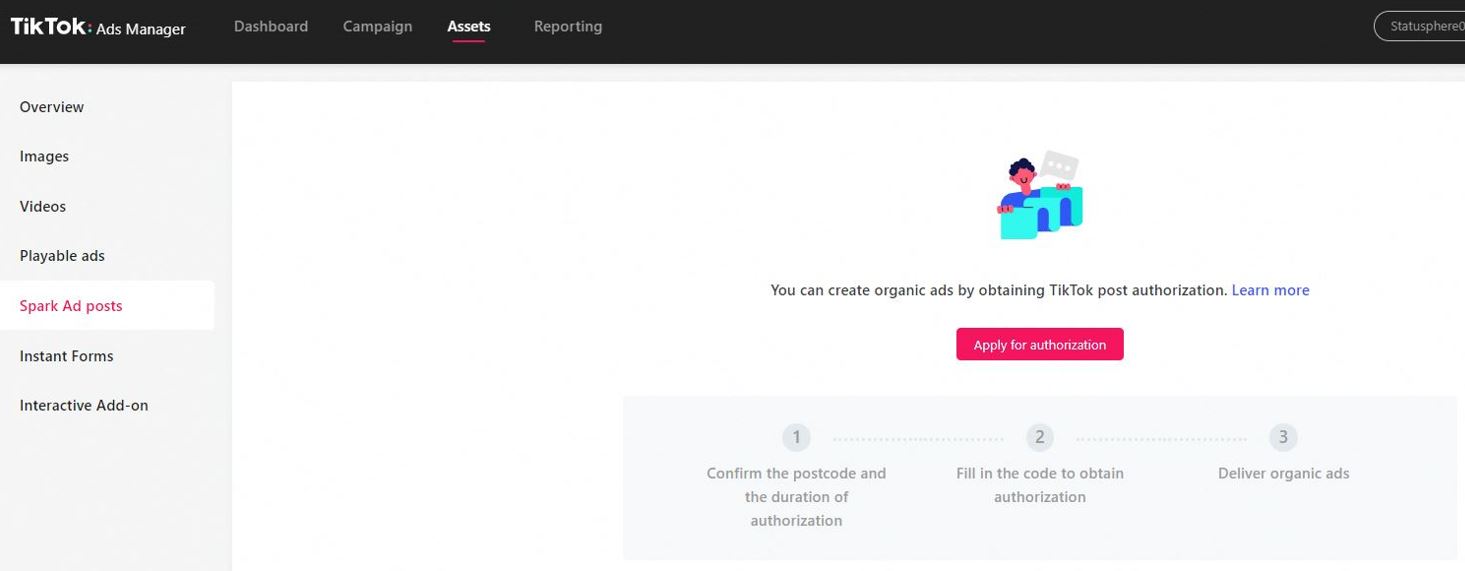 In this step, you will enter the video code provided by the creator. Simply paste the code into the search bar and proceed with the process.
In this step, you will enter the video code provided by the creator. Simply paste the code into the search bar and proceed with the process.
 If the code is correct and the video meets the requirements, a preview of the video will appear. You will also see some information about the approved video, such as its length and resolution. To continue, click “confirm.”
If the code is correct and the video meets the requirements, a preview of the video will appear. You will also see some information about the approved video, such as its length and resolution. To continue, click “confirm.”
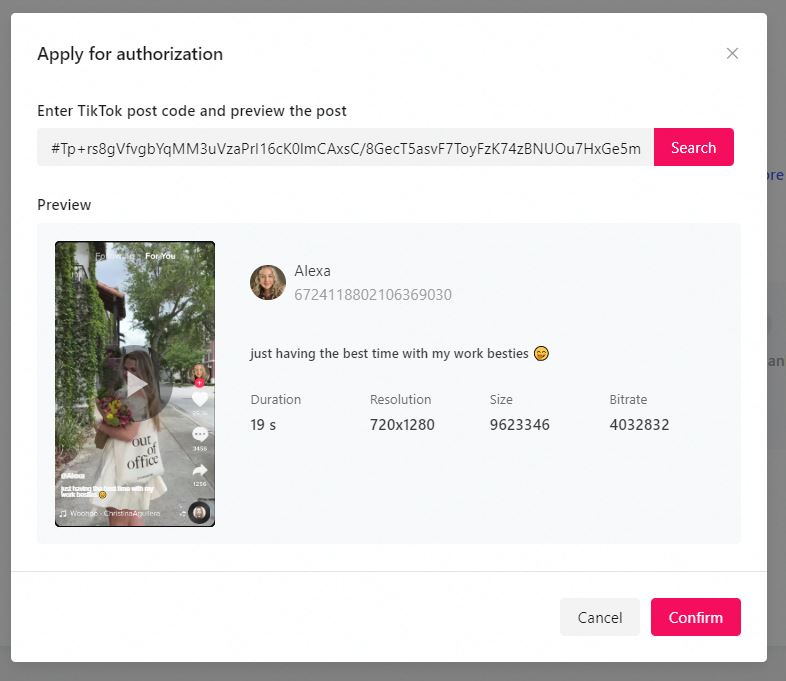 Once your authorization is confirmed, you will be directed to create your Spark Ad.
Once your authorization is confirmed, you will be directed to create your Spark Ad.
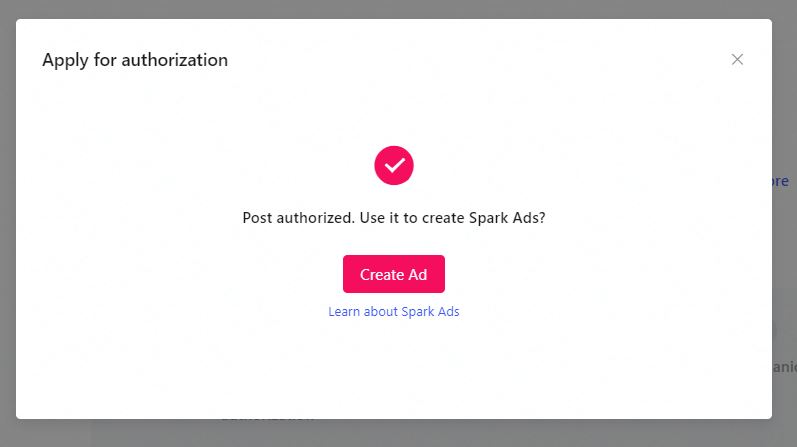
Step 4 (Brand): Specify the Target Audience, Budget, and Goals of Your Ad
Now you will need to specify the details of your ad campaign, including the target audience, budget, and objectives.
The specifics of these details will depend on your business, so we won’t go into too much detail here.
If you are new to TikTok, you can use the “Simplified Mode” to quickly create your ad. Alternatively, the “Custom Mode” allows for a more detailed and customized ad creation process.
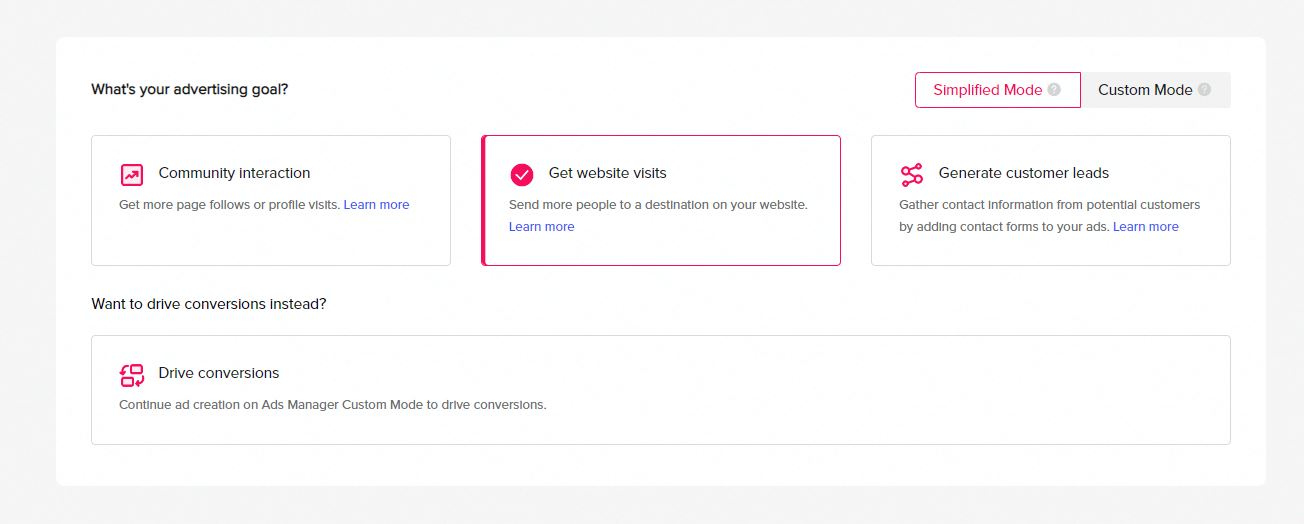 When you reach the “Identity” and “Ad Details” sections of the ad creation process, you are almost done!
When you reach the “Identity” and “Ad Details” sections of the ad creation process, you are almost done!
Step 5 (Brand): Choose Your Creator’s Video and Submit the Ad
In this step, you will link your creator’s video to your ad.
- Under “Identity,” check the box next to “Use TikTok account to deliver Spark ads”.
- Under “Ad Details,” select “Ad format” and then choose your creative (in this case, “Single video”).
- Select “Use other authorized account or post”.
- You should see your creator’s account listed - click on their name.
- Select “TikTok Post”.
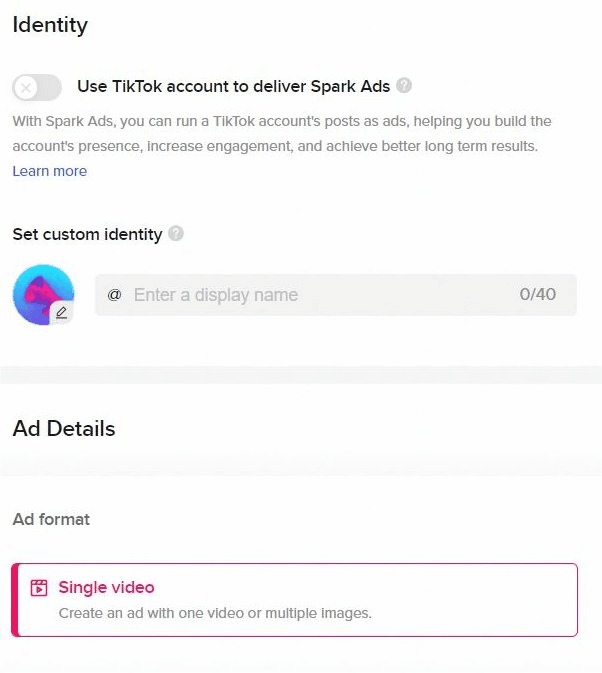 You will then be prompted to browse through the creator’s authorized content. Locate the approved video and select it, then click “Confirm”.
You will then be prompted to browse through the creator’s authorized content. Locate the approved video and select it, then click “Confirm”.
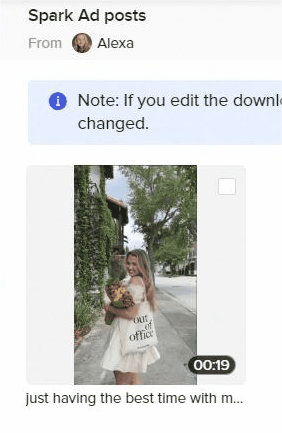 You will see a preview of your Spark Ad. At this point, you can make any necessary adjustments to the details of your creatives, captions, and targeting based on your campaign goals. When you are satisfied with your ad, click “Submit”.
You will see a preview of your Spark Ad. At this point, you can make any necessary adjustments to the details of your creatives, captions, and targeting based on your campaign goals. When you are satisfied with your ad, click “Submit”.
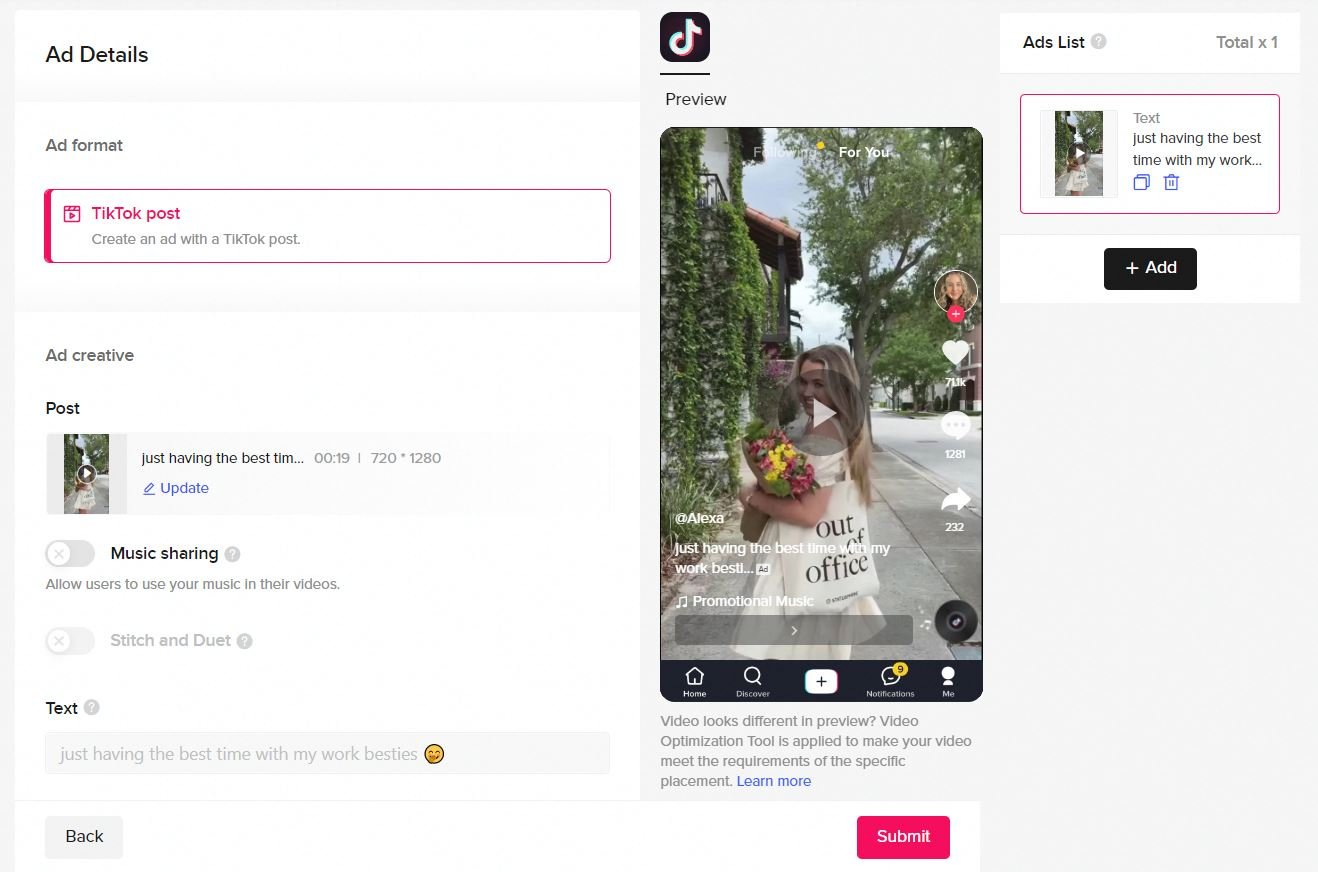 That wasn’t too difficult, was it?
That wasn’t too difficult, was it?
Influencer whitelisting: A marketer’s secret weapon
Influencer whitelisting is a process that allows brands to advertise on Social platforms using content created by popular creators on the platform. It’s a win-win situation: the brand gets to tap into the creator’s audience and the creator gets paid for their content. But influencer whitelisting is much more than just a way to advertise - it’s a marketer’s secret weapon.
One of the biggest benefits of influencer whitelisting is that it allows brands to authentically connect with their audience. When a brand partners with a popular creator, their content is more likely to be perceived as genuine and relatable. This is because the creator already has a strong relationship with their followers, who trust their recommendations and opinions. By leveraging this relationship, the brand can more effectively reach and engage their target audience.
Another advantage of influencer whitelisting is that it can help brands tap into the latest trends and topics on Social platforms. Creators are known for staying on top of the latest memes and trends, and by partnering with them, brands can get in on the action and create content that resonates with their audience. This is particularly useful for brands that want to reach younger consumers, who are often the driving force behind Social platforms trends.
In addition to these benefits, influencer whitelisting also allows brands to save time and resources on content creation. Instead of having to come up with and produce their own content, they can simply use content created by the influencer. This is especially helpful for small businesses or startups that may not have the resources or expertise to create high-quality content on their own.
Overall, influencer whitelisting is a powerful tool for marketers looking to authentically connect with their audience, tap into the latest trends, and save time and resources on content creation. By leveraging the influence of popular creators, brands can effectively reach and engage their target audience on Social platforms.

 Dropshipping agent-Why you need one for 2023
Dropshipping agent-Why you need one for 2023